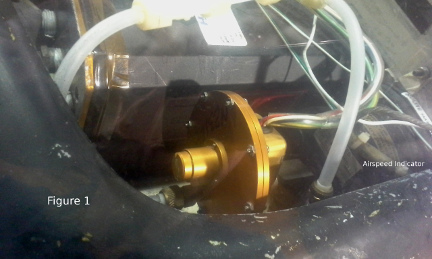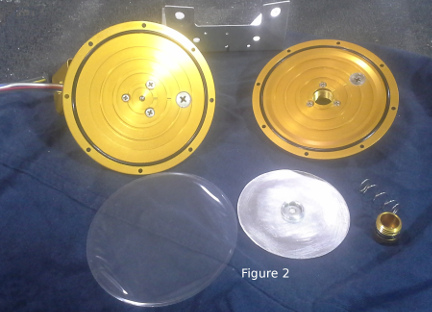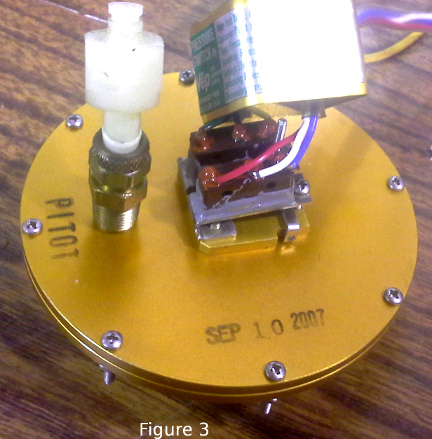Gear up, rotate – No, wait! Electric gear safety system
ShopTalk - January 2019
In this month’s ShopTalk, we will dig into the issue of troubleshooting and repair of the electric landing gear safety system in your Mooney aircraft. You may not know this, but a new landing gear airspeed safety switch will cost you over $1,100 plus labor. First a little history.
When Mooney first developed the retractable gear system in the 1950s for the new M20 series, there was no electric system available. A Johnson bar was attached to the main retraction assembly and an aluminum block was mounted on the airframe at the base of the instrument panel in the centered position. This aluminum block originally only had a hole cut into the base where the spring-loaded handle on the end of the Johnson bar would sit in when the gear was down and locked. After a few gear collapse events, Mooney added a lock pin to the aluminum block and put a slot on the spring-loaded handle to accept the lock pin once the handle was inserted into the down-lock block.
The first electric gear Mooney did not show up until 1966 as an option but many manual gear Mooneys have been converted over to electric gear. This article will not go into all the different electric gear systems Mooney has used over the last 52 years. We will concentrate only on the gear safety switch.
The current Mooney safety switch is different from most general aviation aircraft safety squat switches. Most GA planes have oleo struts (pneumatic air–oil hydraulic shock absorber) with a gear safety switch mounted on one of the struts. As the plane gets lighter during takeoff, the strut extends, the squat switch closes that part of the electric gear circuit, allowing the gear handle switch, when the gear handle is placed in the up position, to complete the circuit and retract the gear.
The Mooney landing gear doesn’t have oleo struts but rather a rubber shock disc. Therefore, the degree of vertical travel as the weight is removed from the wheels is much less. This would be a problem for a squat switch as the adjustment would be very critical. Mooney discovered this as some airplanes in the late 1960s and early 1970s had a squat switch on the left gear. So, Mooney came up with an airspeed safety switch that is directly inline on the pitot system and vented into the static system

There were two different early style airspeed switch assemblies, but later models now use the type shown, usually mounted to the back of the airspeed indicator (see Figure 1). Early J and K airplanes did not use CPC (Circular Plastic Connector) fittings on the wires coming out of the safety switch making it possible to incorrectly connect the circuit. Later models, adopting CPC fittings helped to eliminate wiring errors, even though the connectors may appear to be identical but one side has pins inside and the other has sockets. At sufficient airspeed (approximately 60 knots), pitot pressure acting on a diaphragm enclosed in the gold colored housing (see Figure 2), closes the microswitch for the gear circuit. Now, when the gear handle is placed in the up position, the gear motor is energized for retraction. The airspeed switch is very robust and relatively simple when one looks inside the switch assembly. The gold colored housing is sealed with an O-ring. This airspeed switch assembly typically has two micro switches (see Figure 3). Mooney did make some assemblies with only one switch A cellophane-like diaphragm is located inside with a metal disc that pushes against a button that protrudes out to activate the microswitch(es).
The airspeed switch is very robust and relatively simple when one looks inside the switch assembly. The gold colored housing is sealed with an O-ring. This airspeed switch assembly typically has two micro switches (see Figure 3). Mooney did make some assemblies with only one switch A cellophane-like diaphragm is located inside with a metal disc that pushes against a button that protrudes out to activate the microswitch(es).
The other CPC connector and microswitch may be used to activate an in-flight timer on some clock systems. That is why when you look up under the instrument panel on an M20J or newer planes one of these CPC connectors is typically not used. If the main microswitch fails and no timer is connected, the secondary microswitch may be rewired and utilized for gear safety.
After 1977, a gear bypass button was installed to allow gear retraction without airspeed, mostly utilized for retraction when the airplane is on jacks. Without the bypass, for testing, one must blow into the pitot tube to simulate the airspeed above 60 knots to activate the safety switch.
Any obstruction or contaminants such as oil or water in the pitot or vent (static) will affect the operation of the diaphragm. The switches have adjustable pads where they mount to the case and using an ohmmeter and carefully pressurizing (blowing into) the pitot tube while watching the airspeed indicator, one can tell just what speed is needed to activate the switches.
There are drawbacks to both squat switch and airspeed switch systems. The squat switch is out in the left wheel well and is subjected to all the dirt, water and other debris that is flung up into the wheel well. If your plane is stripped and repainted, this can also affect squat switch operation. Additionally, because the gear discs are rubber, if they don’t expand properly after takeoff, the squat switch will not close allowing the gear to retract, (think: parked outside in the cold, day after day).
Of course, the airspeed safety switch has its drawbacks also. Any blockage in the pitot or static line can affect its proper operation (think: spring-time bugs looking to nest in your pitot line). Because the switch assembly is in the cabin, it is in a much friendlier environment, but when the mechanic pulls your airspeed indicator for overhaul, when re-installed, if the switch wires are misconnected, the gear won’t work. All in all, I think both systems are very reliable.
So, when you are troubleshooting a landing gear problem and suspect the airspeed switch is the culprit, don’t be afraid to take it apart. At 1,100 bucks for a replacement, you can afford to spend an hour or two verifying the switch is actually FUBAR.
If you have questions about this or any other ShopTalk article, please e-mail me at shoptalk@knr-inc.com or call me at my aircraft repair shop, 307-789-6866. All ShopTalk articles can be read here at www.knr‑inc.com. Until next time, enjoy flying your Mooney.
When Mooney first developed the retractable gear system in the 1950s for the new M20 series, there was no electric system available. A Johnson bar was attached to the main retraction assembly and an aluminum block was mounted on the airframe at the base of the instrument panel in the centered position. This aluminum block originally only had a hole cut into the base where the spring-loaded handle on the end of the Johnson bar would sit in when the gear was down and locked. After a few gear collapse events, Mooney added a lock pin to the aluminum block and put a slot on the spring-loaded handle to accept the lock pin once the handle was inserted into the down-lock block.
The first electric gear Mooney did not show up until 1966 as an option but many manual gear Mooneys have been converted over to electric gear. This article will not go into all the different electric gear systems Mooney has used over the last 52 years. We will concentrate only on the gear safety switch.
The current Mooney safety switch is different from most general aviation aircraft safety squat switches. Most GA planes have oleo struts (pneumatic air–oil hydraulic shock absorber) with a gear safety switch mounted on one of the struts. As the plane gets lighter during takeoff, the strut extends, the squat switch closes that part of the electric gear circuit, allowing the gear handle switch, when the gear handle is placed in the up position, to complete the circuit and retract the gear.
The Mooney landing gear doesn’t have oleo struts but rather a rubber shock disc. Therefore, the degree of vertical travel as the weight is removed from the wheels is much less. This would be a problem for a squat switch as the adjustment would be very critical. Mooney discovered this as some airplanes in the late 1960s and early 1970s had a squat switch on the left gear. So, Mooney came up with an airspeed safety switch that is directly inline on the pitot system and vented into the static system


There were two different early style airspeed switch assemblies, but later models now use the type shown, usually mounted to the back of the airspeed indicator (see Figure 1). Early J and K airplanes did not use CPC (Circular Plastic Connector) fittings on the wires coming out of the safety switch making it possible to incorrectly connect the circuit. Later models, adopting CPC fittings helped to eliminate wiring errors, even though the connectors may appear to be identical but one side has pins inside and the other has sockets. At sufficient airspeed (approximately 60 knots), pitot pressure acting on a diaphragm enclosed in the gold colored housing (see Figure 2), closes the microswitch for the gear circuit. Now, when the gear handle is placed in the up position, the gear motor is energized for retraction.
 The airspeed switch is very robust and relatively simple when one looks inside the switch assembly. The gold colored housing is sealed with an O-ring. This airspeed switch assembly typically has two micro switches (see Figure 3). Mooney did make some assemblies with only one switch A cellophane-like diaphragm is located inside with a metal disc that pushes against a button that protrudes out to activate the microswitch(es).
The airspeed switch is very robust and relatively simple when one looks inside the switch assembly. The gold colored housing is sealed with an O-ring. This airspeed switch assembly typically has two micro switches (see Figure 3). Mooney did make some assemblies with only one switch A cellophane-like diaphragm is located inside with a metal disc that pushes against a button that protrudes out to activate the microswitch(es).The other CPC connector and microswitch may be used to activate an in-flight timer on some clock systems. That is why when you look up under the instrument panel on an M20J or newer planes one of these CPC connectors is typically not used. If the main microswitch fails and no timer is connected, the secondary microswitch may be rewired and utilized for gear safety.
After 1977, a gear bypass button was installed to allow gear retraction without airspeed, mostly utilized for retraction when the airplane is on jacks. Without the bypass, for testing, one must blow into the pitot tube to simulate the airspeed above 60 knots to activate the safety switch.
Any obstruction or contaminants such as oil or water in the pitot or vent (static) will affect the operation of the diaphragm. The switches have adjustable pads where they mount to the case and using an ohmmeter and carefully pressurizing (blowing into) the pitot tube while watching the airspeed indicator, one can tell just what speed is needed to activate the switches.
There are drawbacks to both squat switch and airspeed switch systems. The squat switch is out in the left wheel well and is subjected to all the dirt, water and other debris that is flung up into the wheel well. If your plane is stripped and repainted, this can also affect squat switch operation. Additionally, because the gear discs are rubber, if they don’t expand properly after takeoff, the squat switch will not close allowing the gear to retract, (think: parked outside in the cold, day after day).
Of course, the airspeed safety switch has its drawbacks also. Any blockage in the pitot or static line can affect its proper operation (think: spring-time bugs looking to nest in your pitot line). Because the switch assembly is in the cabin, it is in a much friendlier environment, but when the mechanic pulls your airspeed indicator for overhaul, when re-installed, if the switch wires are misconnected, the gear won’t work. All in all, I think both systems are very reliable.
So, when you are troubleshooting a landing gear problem and suspect the airspeed switch is the culprit, don’t be afraid to take it apart. At 1,100 bucks for a replacement, you can afford to spend an hour or two verifying the switch is actually FUBAR.
If you have questions about this or any other ShopTalk article, please e-mail me at shoptalk@knr-inc.com or call me at my aircraft repair shop, 307-789-6866. All ShopTalk articles can be read here at www.knr‑inc.com. Until next time, enjoy flying your Mooney.
